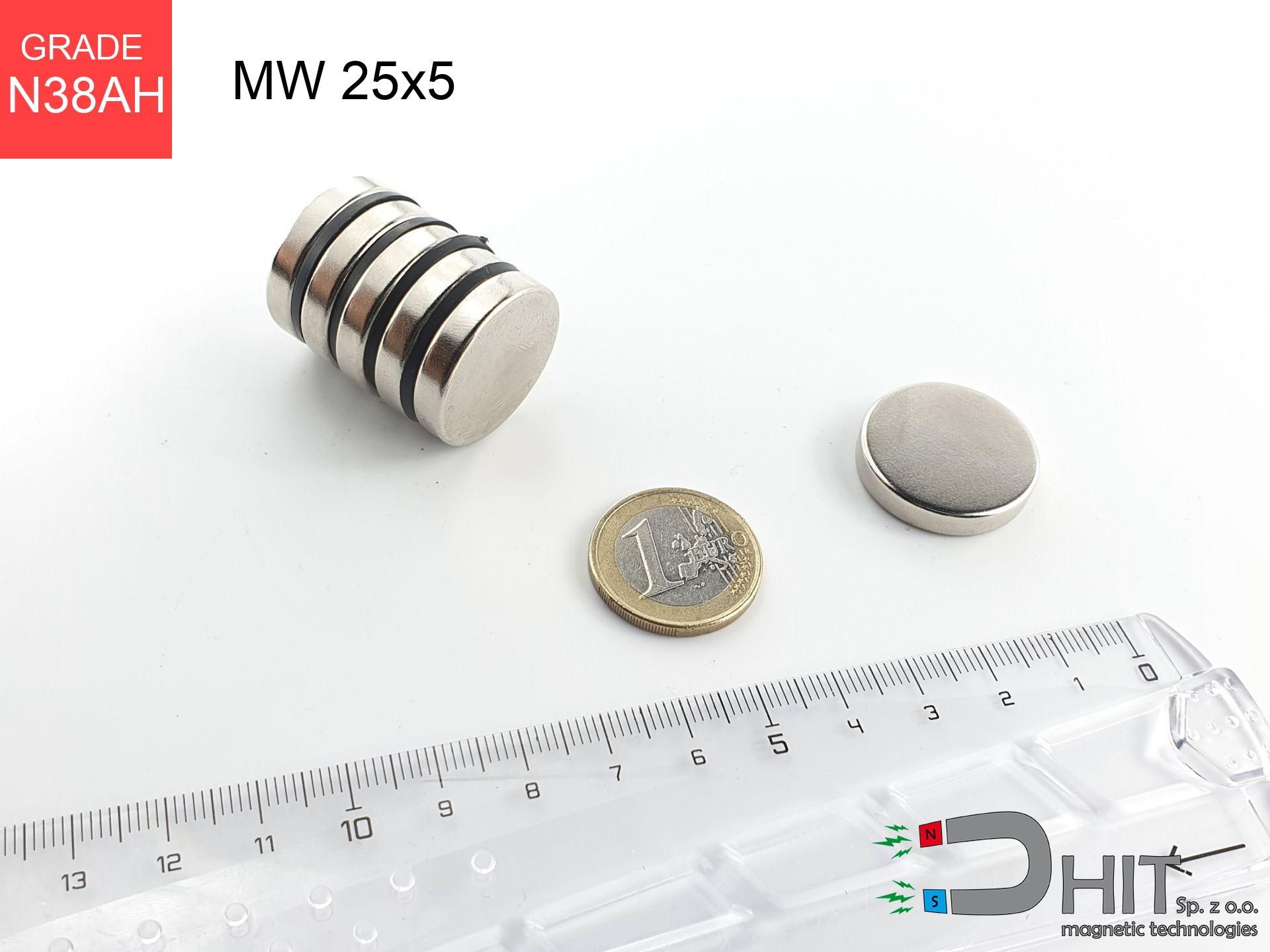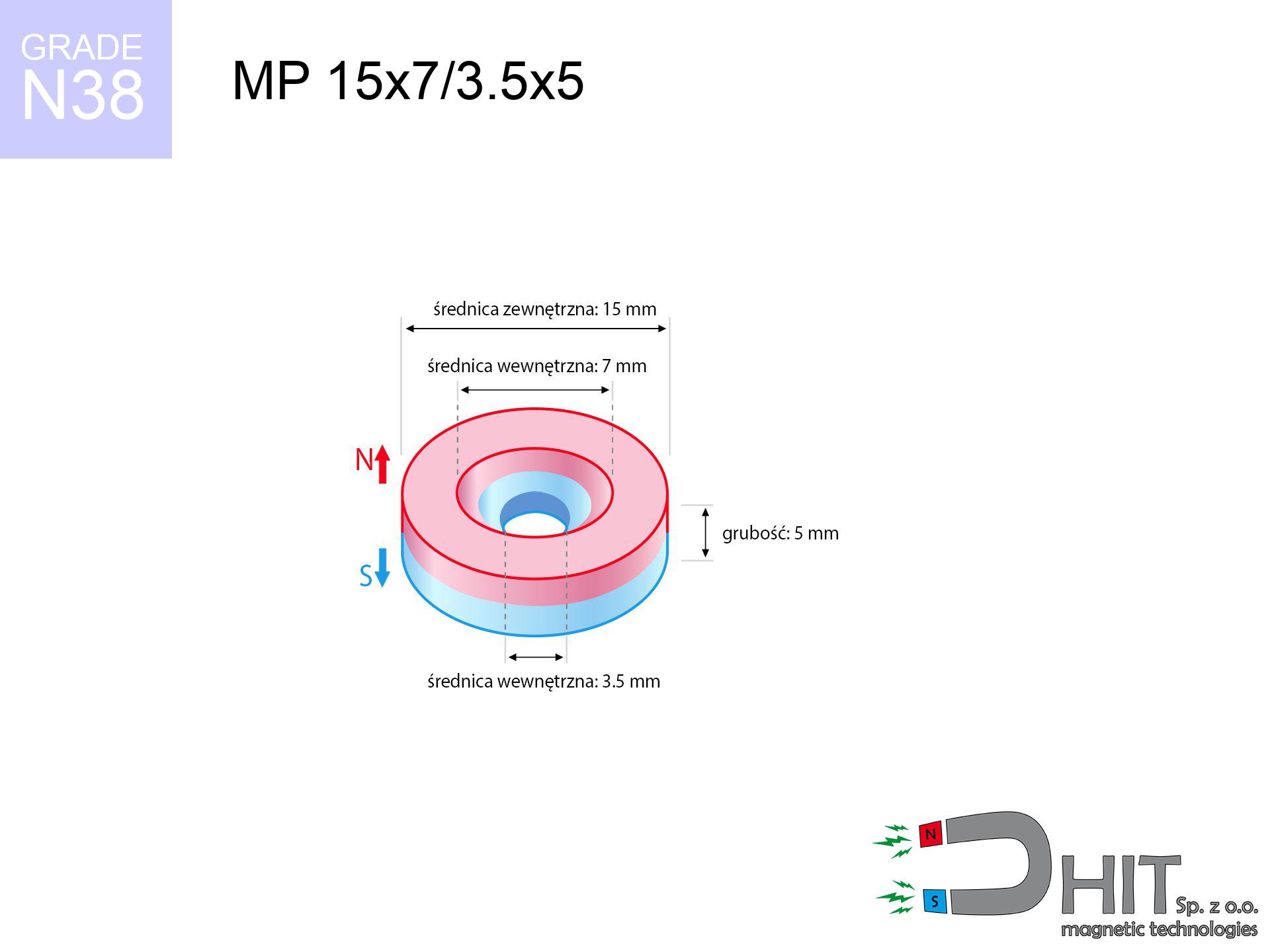MW 25x5 / N38AH - cylindrical magnet
cylindrical magnet
Catalog no 010501
GTIN: 5906301814993
Diameter Ø [±0,1 mm]
25 mm
Height [±0,1 mm]
5 mm
Weight
18.41 g
Magnetization Direction
↑ axial
Load capacity
6.91 kg / 67.76 N
Magnetic Induction
219.99 mT
Coating
[NiCuNi] nickel
16.68 ZŁ with VAT / pcs + price for transport
13.56 ZŁ net + 23% VAT / pcs
bulk discounts:
Need more?Do you have trouble choosing?
Give us a call
+48 888 99 98 98
or get in touch via
inquiry form
the contact page.
Strength and shape of a magnet can be estimated on our
modular calculator.
Order by 14:00 and we’ll ship today!
Magnetic properties of material N38AH
Physical properties of sintered neodymium magnets Nd2Fe14B at 20°C
Shopping tips
Advantages and disadvantages of neodymium magnets.
Besides their durability, neodymium magnets are valued for these benefits:
- They virtually do not lose strength, because even after 10 years the decline in efficiency is only ~1% (based on calculations),
- They show high resistance to demagnetization induced by external magnetic fields,
- The use of an metallic coating of noble metals (nickel, gold, silver) causes the element to be more visually attractive,
- They feature high magnetic induction at the operating surface, which improves attraction properties,
- Due to their durability and thermal resistance, neodymium magnets can operate (depending on the shape) even at high temperatures reaching 230°C or more...
- Thanks to the ability of free shaping and adaptation to specialized needs, NdFeB magnets can be modeled in a variety of shapes and sizes, which increases their versatility,
- Fundamental importance in innovative solutions – they are used in computer drives, electromotive mechanisms, precision medical tools, as well as technologically advanced constructions.
- Relatively small size with high pulling force – neodymium magnets offer impressive pulling force in compact dimensions, which enables their usage in small systems
Disadvantages of neodymium magnets:
- To avoid cracks upon strong impacts, we suggest using special steel housings. Such a solution protects the magnet and simultaneously improves its durability.
- Neodymium magnets lose strength when exposed to high temperatures. After reaching 80°C, many of them experience permanent weakening of power (a factor is the shape as well as dimensions of the magnet). We offer magnets specially adapted to work at temperatures up to 230°C marked [AH], which are very resistant to heat
- When exposed to humidity, magnets start to rust. To use them in conditions outside, it is recommended to use protective magnets, such as magnets in rubber or plastics, which prevent oxidation and corrosion.
- We recommend cover - magnetic mount, due to difficulties in creating nuts inside the magnet and complex forms.
- Potential hazard to health – tiny shards of magnets can be dangerous, when accidentally swallowed, which becomes key in the aspect of protecting the youngest. Furthermore, small components of these devices can be problematic in diagnostics medical in case of swallowing.
- Higher cost of purchase is one of the disadvantages compared to ceramic magnets, especially in budget applications
Highest magnetic holding force – what contributes to it?
Holding force of 6.91 kg is a measurement result conducted under standard conditions:
- on a plate made of mild steel, optimally conducting the magnetic flux
- whose thickness is min. 10 mm
- with an ideally smooth touching surface
- without any clearance between the magnet and steel
- for force acting at a right angle (pull-off, not shear)
- in stable room temperature
Impact of factors on magnetic holding capacity in practice
During everyday use, the actual lifting capacity is determined by many variables, listed from most significant:
- Clearance – existence of any layer (rust, tape, gap) interrupts the magnetic circuit, which reduces capacity rapidly (even by 50% at 0.5 mm).
- Pull-off angle – remember that the magnet holds strongest perpendicularly. Under shear forces, the capacity drops significantly, often to levels of 20-30% of the nominal value.
- Steel thickness – insufficiently thick steel does not accept the full field, causing part of the power to be escaped to the other side.
- Steel grade – ideal substrate is pure iron steel. Cast iron may attract less.
- Surface finish – full contact is possible only on smooth steel. Any scratches and bumps reduce the real contact area, reducing force.
- Thermal factor – hot environment weakens magnetic field. Exceeding the limit temperature can permanently damage the magnet.
* Holding force was measured on the plate surface of 20 mm thickness, when the force acted perpendicularly, whereas under attempts to slide the magnet the lifting capacity is smaller. Additionally, even a slight gap {between} the magnet’s surface and the plate decreases the holding force.
Precautions when working with neodymium magnets
Implant safety
Health Alert: Strong magnets can deactivate heart devices and defibrillators. Stay away if you have electronic implants.
Beware of splinters
Watch out for shards. Magnets can fracture upon violent connection, ejecting shards into the air. Eye protection is mandatory.
Powerful field
Handle magnets consciously. Their powerful strength can surprise even professionals. Plan your moves and respect their power.
Avoid contact if allergic
It is widely known that nickel (the usual finish) is a potent allergen. If you have an allergy, refrain from touching magnets with bare hands or opt for versions in plastic housing.
Magnetic interference
A powerful magnetic field interferes with the operation of compasses in phones and navigation systems. Do not bring magnets near a smartphone to avoid breaking the sensors.
Choking Hazard
Strictly store magnets away from children. Risk of swallowing is significant, and the effects of magnets connecting inside the body are very dangerous.
Crushing risk
Danger of trauma: The pulling power is so great that it can cause hematomas, crushing, and broken bones. Use thick gloves.
Safe distance
Equipment safety: Strong magnets can damage payment cards and sensitive devices (heart implants, medical aids, mechanical watches).
Machining danger
Mechanical processing of neodymium magnets carries a risk of fire hazard. Magnetic powder reacts violently with oxygen and is difficult to extinguish.
Do not overheat magnets
Do not overheat. NdFeB magnets are sensitive to temperature. If you need operation above 80°C, ask us about HT versions (H, SH, UH).
Caution!
Need more info? Check our post: Why are neodymium magnets dangerous?




![SM 32x150 [2xM8] / N42 - magnetic separator SM 32x150 [2xM8] / N42 - magnetic separator](https://cdn3.dhit.pl/graphics/products/sm-32x150-2xm8-xus.jpg)




